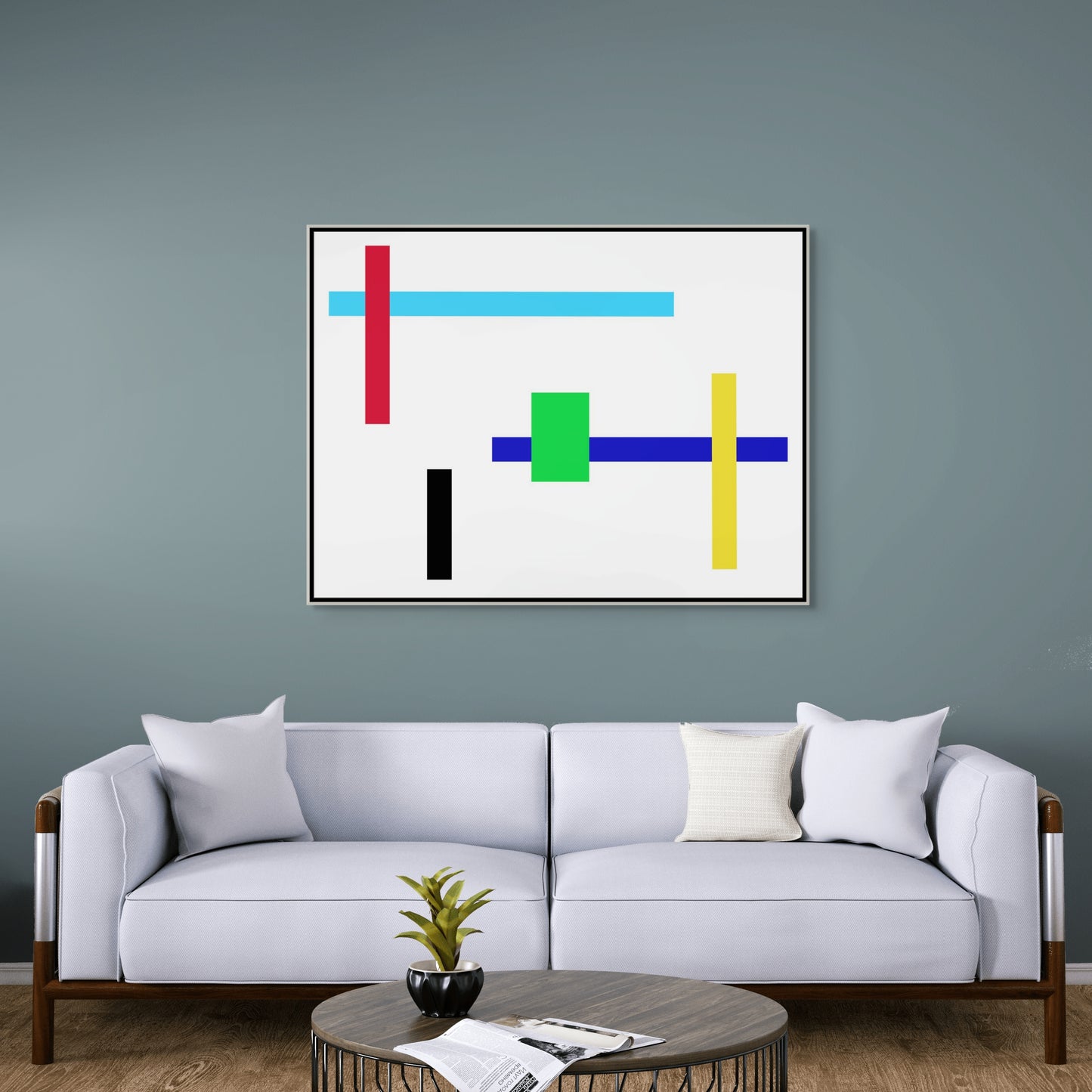The Green Square, 36" x 48"
The Green Square, 36" x 48"
See more paintings from the Floating Color Collection.![]()

James Nowak’s The Green Square, part of his Floating Color Collection, demonstrates the artist’s continuing fascination with geometric abstraction, color dynamics, and spatial tension. In this work, Nowak reduces the visual language to a handful of bold, rectangular forms, arranging them in a way that suggests both order and improvisation. The green square at the center is more than a compositional element—it becomes the conceptual anchor around which the other forms orbit, mediating the painting’s dialogue between color, balance, and meaning.
At first glance, the composition seems deceptively simple: vertical and horizontal rectangles intersect and overlap within an expansive white field. However, their placement creates a rhythm of alignment and misalignment. The central green square is directly attached to a vertical blue bar, forming a cross-like axis. To the left, a sky-blue vertical intersects with a red horizontal, echoing the central structure yet shifting its proportions. At the right edge, a solitary black bar interrupts the otherwise chromatic balance, functioning as a counterweight and reminder of void, seriousness, or pause.
The deliberate spacing between forms is critical. The white negative space becomes an active presence, a stage on which the rectangles float and interact. This recalls the Suprematist and De Stijl traditions, yet Nowak avoids rigid grids, opting instead for asymmetry and looseness.
Unlike the larger expanses of color, the green square occupies a middle scale—not dominating, but not peripheral either. Its position along the central vertical blue line makes it pivotal, bridging top and bottom, left and right. Symbolically, it may represent harmony or synthesis, mediating between the yellow, red, blue, and black forces around it.
Its chromatic quality also stands out: green often symbolizes growth, renewal, or equilibrium. Here, it tempers the intensity of the primaries, suggesting a stabilizing force in an otherwise restless field.
Nowak employs a high-contrast palette: primary red, yellow, and blue dominate, balanced by the secondary green and the stark black. Each hue maintains a flat, unmodulated presence, reinforcing the geometric clarity.
The color interactions are carefully orchestrated:
- The yellow bar radiates warmth and expansiveness, offsetting the cooler tones.
- The red bar grounds the composition, sitting low and left, its weight stabilizing the blue vertical beside it.
- The blue verticals act as structural anchors, guiding the eye upward and downward.
- The black rectangle interrupts harmony, introducing a disruptive, almost existential note.
Together, the colors create a dialogue of tension and resolution, with the green square acting as the mediator.
As with other works in the Floating Color Collection, the sensation of levitation dominates. The shapes are not tethered to any perspectival depth or horizon line; they hover, suspended in pure space. The overlapping of bars with the central vertical blue line intensifies the feeling of crossing trajectories, like beams of light intersecting in mid-air.
The painting oscillates between stability (suggested by its rectilinear vocabulary) and motion (suggested by asymmetry and imbalance). This creates a visual paradox: the viewer perceives both structure and drift simultaneously.
The Green Square conveys both clarity and complexity. Its rigid forms suggest order, discipline, and rationality, but its asymmetry and playful spacing evoke freedom and improvisation. The green square, placed centrally yet modestly, embodies a sense of reconciliation—an emblem of balance amidst competing forces.
The black bar, by contrast, deepens the emotional register. It suggests pause, rupture, or resistance, reminding us that harmony always coexists with disruption.
Nowak’s work sits in dialogue with early 20th-century abstraction. The echoes of Piet Mondrian’s De Stijl are unmistakable in the grid-like interactions of verticals and horizontals, but Nowak resists the rigidity of absolute order. Instead, he embraces the improvisational looseness of Matisse’s cut-outs, where forms seem to float freely across space.
By including the black bar and positioning the green square as a stabilizer, Nowak adds a philosophical layer absent in purely formalist abstraction. The painting becomes not just a formal experiment but a metaphor for coexistence—between structure and freedom, color and void, harmony and disruption.
James Nowak’s The Green Square is a masterful exploration of balance, mediation, and spatial play. The central green square functions as the work’s heartbeat, stabilizing and synthesizing the surrounding forces of color and geometry. Through its combination of precision and openness, the painting transcends formal abstraction, becoming a meditation on harmony and tension in both art and life.

